奥が深すぎる落語の「仕草」って? 思わず描きたくなる落語入門!
昔からストーリーを考えるのが好きだった
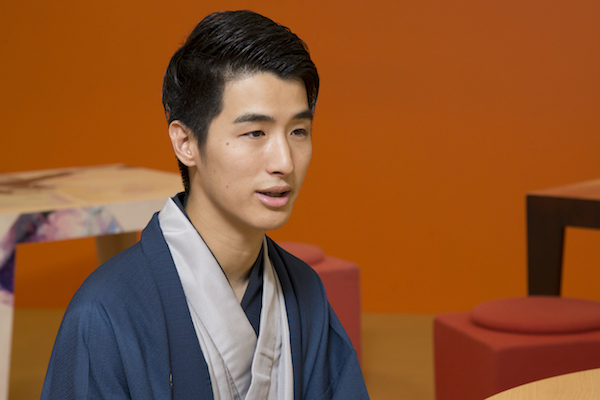
さらに、けい木さんにはインタビューにもお答えいただき、落語をはじめたきっかけや、これから初めて落語を観に行こうという読者へのアドバイスについて伺いました!
──けい木さんは高校を卒業されてすぐ入門されたと伺いました。落語家を目指したきっかけはなんだったんですか?
もともとお笑いが好きだったんです。とくに爆笑オンエアバトルは、毎週欠かさず録画して観ていました。ほかにも笑点だったり、ドリフターズだったり、チャップリンだったり、ミスタービーンだったり……。いろいろ観ていましたね。
──その中で落語という道を選んだきっかけはなんだったんですか?
実家が商売をやっていたので、いつもおじいちゃんとおばあちゃんが面倒を見てくれたんですね。それで毎週日曜、近所で遊んで帰ってくると、きまって笑点を見るんです。
その中で、子どもにもわかりやすくて、おもしろい答えをしていたのが師匠の林家木久扇。この人、おもしろいなって。そのとき落語家という道がぼんやりと見えた気がします。たしか、小学校3年生のときでした。
その中で、子どもにもわかりやすくて、おもしろい答えをしていたのが師匠の林家木久扇。この人、おもしろいなって。そのとき落語家という道がぼんやりと見えた気がします。たしか、小学校3年生のときでした。
──そのままずっと落語家を目指していたんですか?
そうですね。でも実は、漫画家になりたいと思った時期もあったんですよ。実家にまだ自分で創作した漫画が残っています。ただ絵を描くよりストーリーを考えることの方が好きでしたね。それから映画監督にもなりたかったです。
──そうなんですね! けい木さんは創作落語を作っていらっしゃいますが、昔からクリエイティブなことがお好きだったんですね。
今風な言葉で言うならそうかもしれないですね。昔からストーリーを考えるのは好きだったので。
落語家が100人いれば100通りの演出がある
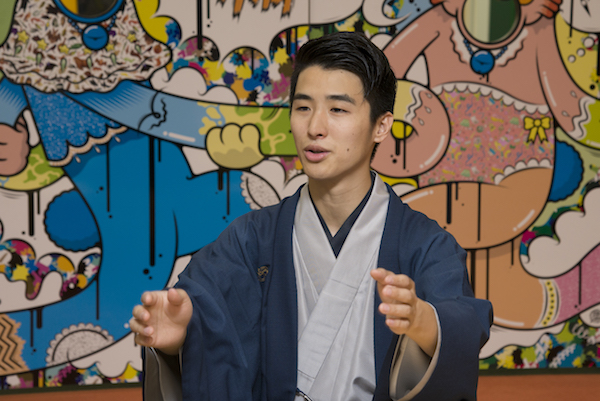
──入門すると、まずは噺を覚えるところから始まるんですよね。
いま古典落語は30席以上持ちネタがありますが、自分の師匠に教えいていただいたのは2席だけです。あとは、兄弟弟子やほかの一門の先輩方にお願いして教えていただきます。自分の師匠からしか教わらないとどうしてもコピーになってしまいますし、みんなそれぞれ持ちネタがありますから。
──稽古はどういう風に行うんですか?
一対一でやってみせていただいて、それをレコーダーで撮って、覚えて。それを今度は自分がやるのをみてもらうんです。そうして上達すると、今度はお客様の前でやってごらんという感じですね。修行中は毎日寄席に通うんですが、「あのひとのこれを教わりたいな」というのを、僕はリストアップしていました。
──やっぱり人によって演じ方は違いますか?
落語家が100人いれば100通りの演出がありますよ。ある程度型はありますが、最終的にはオリジナリティということになるんでしょうね。
僕は映画が好きなので、映画の登場人物の特徴を自分の中にインプットして、落語の登場人物の中にエッセンスを加えてみることもあります。
僕は映画が好きなので、映画の登場人物の特徴を自分の中にインプットして、落語の登場人物の中にエッセンスを加えてみることもあります。
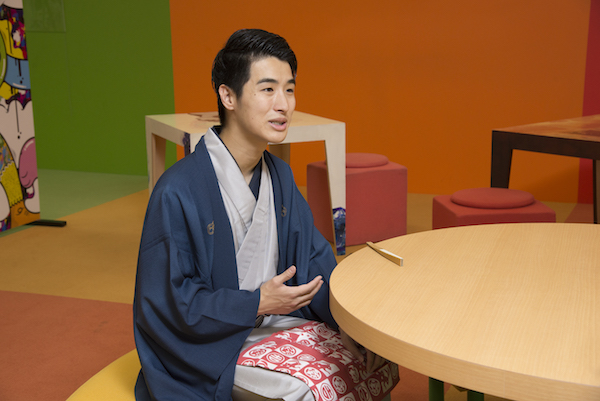
──これができたら一人前、という基準はあるんですか?
学校とは違うので、必修科目のようなものはないんです。たとえば自分の持ちネタの中におそばを食べる仕草があれば練習します。自分の仕草がお客さんにウケるとうれしいですね。
──落語には登場人物がたくさん出てきますが、どうやって演じ分けるんですか?
役によって、見る方向を変えるんです。これを「上下(かみしも)を切る」といいます。基本的に目上の人が下手、目下のものが上手を見ると決まっているんです。落語家によっては思い切り横を向いて上下を切る方もいますが、僕はお客様に表情を見ていただきたいので、振り幅は狭めにしています。
きっかけは何でもいい。とにかく落語を聞きに来て!
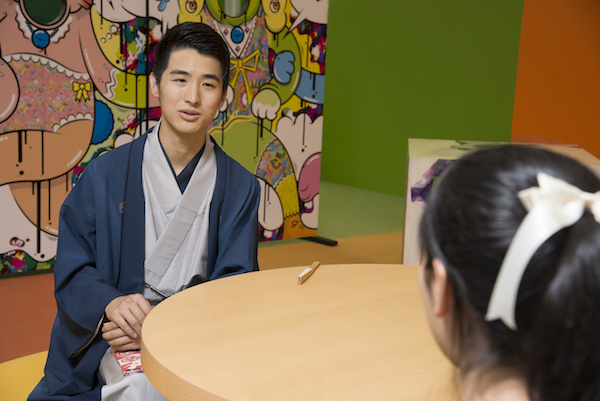
──初めて落語を観るにあたって、知っておいた方がいいことはありますか?
小学校や中学校で寄席をやることがあるんですが、そのときははじめに寄席教室というものをやるんですね。そのあとに寄席を見てもらって。でも普通の寄席だとそういうのはないですからね。
難しい噺だと、何がなんだかわからなかったということもあるかもしれません。でも、設定が江戸とか明治というだけで、描かれている話は今の自分たちと通じ合う部分も多いと思います。それから、けっこうメモをとっているお客様も多いですよ。わからないことがあったらメモにとっておいてあとから調べるのもいいと思います。
難しい噺だと、何がなんだかわからなかったということもあるかもしれません。でも、設定が江戸とか明治というだけで、描かれている話は今の自分たちと通じ合う部分も多いと思います。それから、けっこうメモをとっているお客様も多いですよ。わからないことがあったらメモにとっておいてあとから調べるのもいいと思います。
──なるほど。あんまり気負わなくてもいいんですかね?
僕らが話してることが100%面白いということはないので、自分にハマったときとか、共感したときとかに笑ってくださればいいんです。僕自身、普段落語を聞かないという人にこそ、どんどん興味を持っていただきたいと思ってますから。
実は今、都内だけで毎月800くらいの落語イベントがあるんですよ。
実は今、都内だけで毎月800くらいの落語イベントがあるんですよ。
──ええ!? そんなに?
美容室でやったり、バーでやったり、ライブスペースがあるレストランでやったり……。それから僕はYouTubeに動画を載せることもあります。
──落語を見られるのは寄席だけじゃないんですね。
はじめは、若手がやっている近所のイベントに足を運んでいただいて、そこから徐々に本格的な寄席にも行っていただけたらいいなと思います。
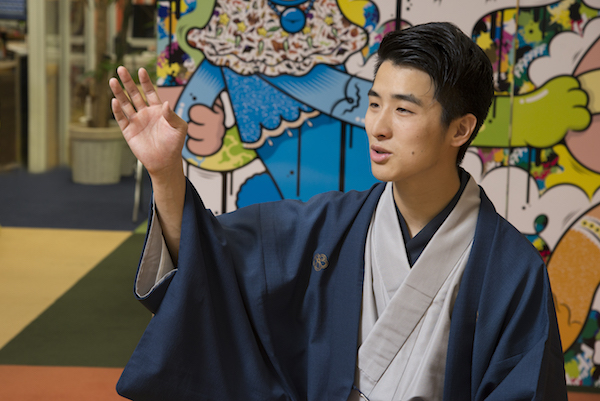
──ご自身で創作落語を作られているのも、多くの人に落語を広めたいという気持ちからですか?
そうですね。僕は映画が好きなんですけど、ほかにも都市伝説やオカルトも好きで。そういうちょっと”怪しさ"がある題材って興味を引かれる人が多いと思うんです。それからオペラで、戦地に赴くという設定だったものを、出張に行くと今風にアレンジしているものがあって。落語にもそういう転換は必要かもしれないですね。
──最後に、これから落語を聞いてみたいと思っている読者に向けてメッセージをお願いします。
あまり難しく考えすぎず、軽い気持ちで足を運んでみてください。
入り方はなんでもよくて、たとえばタイプの落語家がいるとか、そんなことでいいんです。気負わず笑いに来てください。
入り方はなんでもよくて、たとえばタイプの落語家がいるとか、そんなことでいいんです。気負わず笑いに来てください。
──ありがとうございました!
落語は聞くというより、場の空気を楽しむものかも
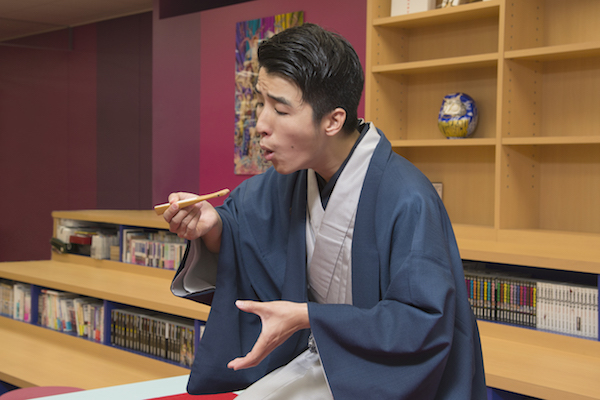
けい木さんはまだ20代。自分と同じような若い世代にももっと落語に親しんでもらえたいと思っていらっしゃるそうです。
さらに今回、ご好意で『あくび指南』という演目を演じてくださりました! 急遽開催されたピクシブ寄席の様子はこちらから。
さらに今回、ご好意で『あくび指南』という演目を演じてくださりました! 急遽開催されたピクシブ寄席の様子はこちらから。
実際にけい木さんの噺を聞いていて、落語というのは落語家と客が一緒になって作り上げる舞台なのではないかと思いました。落語家が見せてくれる芸に対して、客は「笑い」で応える。その関係性の中で生まれた「場の空気」がもっと舞台をおもしろく、楽しく洗練させていくように感じたからです。
落語はきっとその場の空気を楽しみに行くもの。大切なのは、足を運んで、落語家の芸を素直に笑うことなのではないでしょうか。けい木さんの言うように、まずは軽い気持ちで出かけてみてもいいのかもしれません。
落語はきっとその場の空気を楽しみに行くもの。大切なのは、足を運んで、落語家の芸を素直に笑うことなのではないでしょうか。けい木さんの言うように、まずは軽い気持ちで出かけてみてもいいのかもしれません。
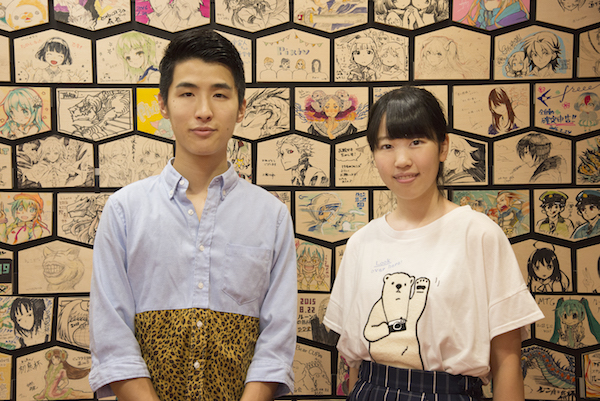
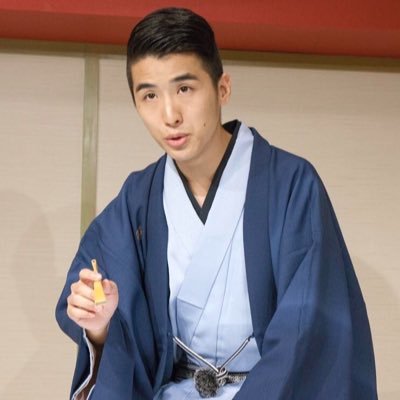
- 林家けい木
- 2010年2月林家木久扇に入門、3月命名「けい木」。8月に楽屋入り、前座となる。2015年5月二つ目昇進。寄席以外にも学校、介護施設、カフェ、バー、美容室、アパレルショップなどで落語会を開催。古典落語だけでなく、新作・改作・怪談・ウクレレ漫談・ものまね・レポーターなど幅広く活動中。

- 白森さわ
- ピクシブプロダクション所属・つくドルプロジェクト公式イラストレーター。1999年4月生まれ。高校2年生。2015年5月にデビュー、今年3月には自身初となる単行本「ぴくし部」を発売。日々創作活動中です!
【最新情報】
白森さわと甲斐莉乃のいのこりスケッチ放送部
つくドル!イラストレーターチームの二人、白森さわ&甲斐莉乃によるニコニコ生放送がスタート!真面目だけどあがり症な白森と、とにかくマイペースな甲斐がのんびりお絵かきしながらガールズ(?)トークを繰り広げます。

公演情報
日時:8月14日(日) 20:00 開演
住所:東京都 武蔵野市 吉祥寺本町 1-23-7 B1
料金:落語チャージ 1,000円
※ 休憩あり、全3席予定
HMV&BOOKS落語会
日時:8月19日(金)、9月9日(金)、10月21(金)、11/18(金)、12月16日(金)
19:00 開場/19:30 開演(全日共通)
会場:HMV&BOOKS TOKYO(渋谷Modi6F)
料金:木戸銭 1500円(プラス別途1ドリンク500円)
※ HMV&BOOKS TOKYO6F ローチケカウンターに加えて、全国のローソン店内のLoppiでもチケットが購入可能です。
ジャポニカ寄席
日時:8月20日(土) 18:00 開演
会場:ROBE JAPONICA SALON
住所:東京都渋谷区神宮前3-25-6 サンビューティ原宿1F
開演 18:00
料金:木戸銭 1500円(学生 1000円)
お問い合わせ:03-6804-2780